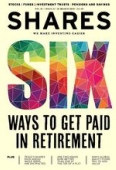Archived article
Please note that tax, investment, pension and ISA rules can change and the information and any views contained in this article may now be inaccurate.
Why do share prices change overnight?

Relative newcomers to investing may be confused by the fact share prices can move between days, apparently without any trading taking place.
Even more experienced investors often grumble darkly about these moves and in some cases the difficulty in buying as much as they want of a stock when it is moving higher.
For example, a small cap healthcare firm could announce a breakthrough with clinical trials of a new drug at 7am and at 8am, when trading resumes, you might find the shares are materially higher before you’ve even had a chance to participate in the rally.
An opening auction starts at 7.50am where certain individuals can place bids to buy and sell shares during a 10-minute period in order to help determine the opening price at 8am. Only people with access to the London Stock Exchange’s order book can participate and in general retail investors using an investment platform won’t have access to this service.
Also behind these out-of-hours movements in share prices are market makers. These are banks or stockbrokers who commit to trading shares, investment trusts, exchange-traded funds and bonds to ensure you are always able to buy or sell on an exchange in normal market hours. There are more than 20 registered market makers with the London Stock Exchange.
Market makers are obviously involved in this activity to make money and they do so through the spread – the difference between the price at which you buy and sell a share. But it is not just this commercial element which dictates the gap.
The ‘bid’ is the price at which the holder can sell shares and the ‘offer’ is the price at which you can buy shares. Almost 100% of the time the bid price will be below the offer price. The size of the difference or spread is largely a function of how liquid a stock is or in other words how easy it is to buy or sell.
Market makers have more impact on companies at the smaller end of the spectrum as big stocks, such as consumer goods giant Unilever (ULVR), have plenty of investors who are willing to trade without the intervention of these professionals. Here buy and sell orders are typically matched through the SETS electronic trading system.
MORE RELEVANT TO SMALL CAP STOCKS
Smaller firms might only have one or two market makers and here the difference between the bid and offer price can be significantly higher.
To take a real-world example, on 14 March biological products firm Plant Health Care (PHC:AIM) traded at a bid price of 5.55p and an offer price of 6.45p.
These figures imply you would pay 6.45p to buy the shares and get 5.55p if you tried to sell them – so in effect you would be sitting on a paper loss as soon as your initial buy order is placed.
You would need the bid price to increase by 16% to 6.45p just to stand a chance of breaking even on your trade if you looked to sell.
DICTATED BY SUPPLY AND DEMAND
The regulatory set-up for market makers, as for other parts of the financial markets, is stricter than it was historically but there is certainly no rule which says a stock has to open at the level it closed at the previous day.
Market makers, which usually only keep a relatively small number of the relevant shares on hand, will set their price at a level which they know they will be able to both buy and sell stock.
To take our hypothetical example of the small cap healthcare play, if the market maker took no account of the clinical trials breakthrough, and just set their price at the level it closed the night before, they would not be able to persuade any shareholders to sell and therefore wouldn’t have any stock available for people to buy.
This is further complicated by the fact that some small cap stocks have a very limited ‘free float’. This refers to the portion of a company’s shares which are freely bought or sold, rather than being held by directors or large institutional investors.
After all, market makers have to provide ‘two-way continuous pricing’. In simple terms this means that for the shares they are registered to make a market in, the firms must, throughout the trading day, provide prices at which the shares can be bought and sold. They are mandated to do this up to a certain size of trade known as the normal market size (NMS).
If you are looking to buy shares which are rising sharply, you may find it difficult to buy large quantities but again this is likely because the market maker is struggling to find sellers from whom to buy stock. Remember, they are only obliged to trade at the NMS and this can be quite a modest amount for small cap stocks.
Important information:
These articles are provided by Shares magazine which is published by AJ Bell Media, a part of AJ Bell. Shares is not written by AJ Bell.
Shares is provided for your general information and use and is not a personal recommendation to invest. It is not intended to be relied upon by you in making or not making any investment decisions. The investments referred to in these articles will not be suitable for all investors. If in doubt please seek appropriate independent financial advice.
Investors acting on the information in these articles do so at their own risk and AJ Bell Media and its staff do not accept liability for losses suffered by investors as a result of their investment decisions.

 magazine
magazine









